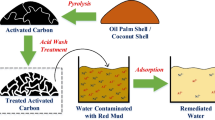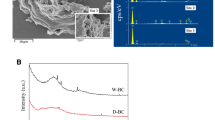Abstract
In this study, crayfish shell was pyrolyzed at 600 °C to obtain an unmodified biochar (CS600). MgCl2 was used as a modifier to pretreat crayfish shell to produce a modified biochar (CS600-MgCl2) under the same pyrolysis conditions. The two biochars were characterized for physicochemical properties and evaluated for lead (Pb2+) sorption ability to determine the modification mechanism. Mono-element batch adsorption experiments were conducted to compare the sorption performances of CS600 and CS600-MgCl2 to Pb2+ in aqueous solutions. All the experiments were carried out at pH of 7. According to the Freundlich–Langmuir model, CS600-MgCl2 had a higher adsorption capacity (152.3 mg/g) than CS600 (134.3 mg/g). FTIR, SEM, XRD, BET, and ICP analyses were applied to inform the interpretation of the mechanism. CS600 was calcium-rich and mainly removed Pb2+ through the ion exchange mechanism by replacing Ca2+ in the biochar. The increased Pb2+ adsorption capacity of CS600-MgCl2 was mainly due to the enlarged specific surface area and the formation of Mg3(OH)5Cl·4H2O on the modified biochar. Findings of this study suggest that both CS600 and CS600-MgCl2 can be used to remove heavy metal ions from wastewater and MgCl2 can improve the sorption performance of biochar.





Similar content being viewed by others
References
Anayurt RA, Sari A, Tuzen M (2009) Equilibrium, thermodynamic and kinetic studies on biosorption of Pb(II) and Cd(II) from aqueous solution by macrofungus (Lactarius scrobiculatus) biomass. Chem Eng J 151:255–261
Burakov AE, Galunin EV, Burakova IV, Kucherova AE, Agarwal S, Tkachev AG, Gupta VK (2018) Adsorption of heavy metals on conventional and nanostructured materials for wastewater treatment purposes: a review. Ecotox Environ Safe 148:702–712
Chang HYH, Kuo YL, Liu JC (2019) Fluoride at waste oyster shell surfaces - role of magnesium. Sci Total Environ 652:1331–1338
Dialynas E, Diamadopoulos E (2009) Integration of a membrane bioreactor coupled with reverse osmosis for advanced treatment of municipal wastewater. Desalination 238:302–311
Hu X, Xue Y, Liu L, Zeng Y, Long L (2018a) Preparation and characterization of Na2S-modified biochar for nickel removal. Environ Sci Pollut Res 34:1–9
Hu X, Xue Y, Long L, Zhang K (2018b) Characteristics and batch experiments of acid- and alkali-modified corncob biomass for nitrate removal from aqueous solution. Environ Sci Pollut Res 25:1–9
Islam MS, Ahmed MK, Habibullah-Al-Mamun M, Islam KN, Ibrahim M, Masunaga S (2014) Arsenic and lead in foods: a potential threat to human health in Bangladesh. Food Addit Contam Part A-Chem 31:1982–1992
Jayawardhana Y, Gunatilake SR, Mahatantila K, Ginige MP, Vithanage M (2019) Sorptive removal of toluene and m-xylene by municipal solid waste biochar: simultaneous municipal solid waste management and remediation of volatile organic compounds. J Environ Manag 238:323–330
Jing XR, Wang YY, Liu WJ, Wang YK, Jiang H (2014) Enhanced adsorption performance of tetracycline in aqueous solutions by methanol-modified biochar. Chem Eng J 248:168–174
Karunanayake AG, Todd OA, Crowley M, Ricchetti L, Pittman CU, Anderson R, Mohan D, Mlsna T (2018) Lead and cadmium remediation using magnetized and nonmagnetized biochar from Douglas fir. Chem Eng J 331:480–491
Kaygusuz MK, Isik NO, Erden KE (2017) THE removal of Pb(II) from aqueous solutions by strong and weak acidic cation exchange resins. Fresenius Environ Bull 26:3448–3454
Kolodynska D, Krukowska J, Thomas P (2017) Comparison of sorption and desorption studies of heavy metal ions from biochar and commercial active carbon. Chem Eng J 307:353–363
Kumar JK, Prasad AD (2011) Identification and comparison of biomolecules in medicinal plants of Tephrosia tinctoria and Atylosia albicans by using FTIR. Rom J Biophys 21:63–71
Li CW, Liang YM, Chen YM (2005) Combined ultrafiltration and suspended pellets for lead removal. Sep Purif Technol 45:213–219
Li HB, Dong XL, da Silva EB, de Oliveira LM, Chen YS, Ma LNQ (2017a) Mechanisms of metal sorption by biochars: biochar characteristics and modifications. Chemosphere 178:466–478
Li Q, Gao YT, Lang J, Ding WC, Yong Y (2017b) Removal of Pb(II) and Cu(II) from aqueous solutions by ultraviolet irradiation-modified biochar. Desalin Water Treat 82:179–187
Liu BJ, Lv X, Meng XH, Yu GL, Wang DF (2013) Removal of Pb(II) from aqueous solution using dithiocarbamate modified chitosan beads with Pb(II) as imprinted ions. Chem Eng J 220:412–419
Long L, Xue Y, Zeng Y, Yang K, Lin C (2017) Synthesis, characterization and mechanism analysis of modified crayfish shell biochar possessed ZnO nanoparticles to remove trichloroacetic acid. J Clean Prod 166:1244–1252
Luo L, Xu C, Chen Z, Zhang S (2015) Properties of biomass-derived biochars: combined effects of operating conditions and biomass types. Bioresour Technol 192:83–89
Ma Y, Liu WJ, Zhang N, Li YS, Jiang H, Sheng GP (2014) Polyethylenimine modified biochar adsorbent for hexavalent chromium removal from the aqueous solution. Bioresour Technol 169:403–408
Majidnia Z, Idris A (2016) Synergistic effect of maghemite and titania nanoparticles in PVA-alginate encapsulated beads for photocatalytic reduction of Pb(II). Chem Eng Commun 203:425–434
Nadarajah K, Prinyawiwatkul W, No HK, Sathivel S, Xu ZM (2006) Sorption behavior of crawfish chitosan films as affected by chitosan extraction processes and solvent types. J Food Sci 71:E33–E39
Ngah WSW, Fatinathan S (2010) Pb(II) biosorption using chitosan and chitosan derivatives beads: equilibrium, ion exchange and mechanism studies. J Environ Sci 22:338–346
Otero-Fernandez A, Otero JA, Maroto-Valiente A, Calvo JI, Palacio L, Pradanos P, Hernandez A (2018) Reduction of Pb(II) in water to safe levels by a small tubular membrane nanofiltration plant. Clean Techn Environ Policy 20:329–343
Pang FM, Teng SP, Teng TT, Omar AKM (2009) Heavy metals removal by hydroxide precipitation and coagulation-flocculation methods from aqueous solutions. Water Qual Res J Canada 44:174–182
Peng XJ, Luan ZK, Di ZC, Zhang ZG, Zhu CL (2005) Carbon nanotubes-iron oxides magnetic composites as adsorbent for removal of Pb(II) and Cu(II) from water. Carbon 43:880–883
Schulte A, Balazs A, Block J, Gehrmann J (1996) Development of heavy-metal deposition by precipitation in West Germany.1. Lead and cadmium. Z Pflanzen Bodenk 159:377–383
Tan GQ, Wu Y, Liu Y, Xiao D (2018) Removal of Pb(II) ions from aqueous solution by manganese oxide coated rice straw biochar - a low-cost and highly effective sorbent. J Taiwan Inst Chem Eng 84:85–92
Viravaidya C, Li M, Mann S (2004) Microemulsion-based synthesis of stacked calcium carbonate (calcite) superstructures. Chem Commun:2182–2183
Wang HY, Gao B, Wang SS, Fang J, Xue YW, Yang K (2015) Removal of Pb(II), Cu(II), and Cd(II) from aqueous solutions by biochar derived from KMnO4 treated hickory wood. Bioresour Technol 197:356–362
Wang SJ, Guo W, Gao F, Yang R (2017) Characterization and Pb(II) removal potential of corn straw- and municipal sludge-derived biochars. R Soc Open Sci 4:11
Wu WD, Li JH, Lan T, Muller K, Niazi NK, Chen X, Xu S, Zheng LR, Chu YC, Li JW, Yuan GD, Wang HL (2017) Unraveling sorption of lead in aqueous solutions by chemically modified biochar derived from coconut fiber: a microscopic and spectroscopic investigation. Sci Total Environ 576:766–774
Xiao YL, Xue YW, Gao F, Mosa A (2017) Sorption of heavy metal ions onto crayfish shell biochar: effect of pyrolysis temperature, pH and ionic strength. J Taiwan Inst Chem Eng 80:114–121
Xie FZ, Lin XC, Wu XP, Xie ZH (2008) Solid phase extraction of lead (II), copper (II), cadmium (II) and nickel (II) using gallic acid-modified silica gel prior to determination by flame atomic absorption spectrometry. Talanta 74:836–843
Xue Y, Gao B, Yao Y, Inyang M, Zhang M, Zimmerman AR, Ro KS (2012) Hydrogen peroxide modification enhances the ability of biochar (hydrochar) produced from hydrothermal carbonization of peanut hull to remove aqueous heavy metals: batch and column tests. Chem Eng J 200-202:673–680
Yang GX, Jiang H (2014) Amino modification of biochar for enhanced adsorption of copper ions from synthetic wastewater. Water Res 48:396–405
Yin QQ, Liu MT, Ren HP (2019) Removal of ammonium and phosphate from water by Mg-modified biochar: influence of Mg pretreatment and pyrolysis temperature. BioResources 14:6203–6218
Zama EF, Zhu YG, Reid BJ, Sun GX (2017) The role of biochar properties in influencing the sorption and desorption of Pb(II), Cd(II) and As(III) in aqueous solution. J Clean Prod 148:127–136
Zeng YF, Xue YW, Long L, Yan JP (2019) Novel crayfish shell biochar nanocomposites loaded with Ag-TiO2 nanoparticles exhibit robust antibacterial activity. Water Air Soil Pollut 230:9
Zhang W, Song J, He Q, Wang H, Lyu W, Feng H, Xiong W, Guo W, Wu J, Chen L (2019a) Novel pectin based composite hydrogel derived from grapefruit peel for enhanced Cu(II) removal. J Hazard Mater 384:121445
Zhang W, Wang H, Hu X, Feng H, Xiong W, Guo W, Zhou J, Mosa A, Peng Y (2019b) Multicavity triethylenetetramine-chitosan/alginate composite beads for enhanced Cr(VI) removal. J Clean Prod 231:733–745
Funding
This work was partially supported by the National “Twelfth Five-Year” Plan for Science & Technology Pillar Program (grant number 2014BAL04B04), and the Wuhan Water Engineering & Technology Co. Ltd.
Author information
Authors and Affiliations
Corresponding author
Additional information
Responsible editor: Philippe Garrigues
Publisher’s note
Springer Nature remains neutral with regard to jurisdictional claims in published maps and institutional affiliations.
Rights and permissions
About this article
Cite this article
Zhang, J., Hu, X., Yan, J. et al. Crayfish shell biochar modified with magnesium chloride and its effect on lead removal in aqueous solution. Environ Sci Pollut Res 27, 9582–9588 (2020). https://doi.org/10.1007/s11356-020-07631-9
Received:
Accepted:
Published:
Issue Date:
DOI: https://doi.org/10.1007/s11356-020-07631-9




